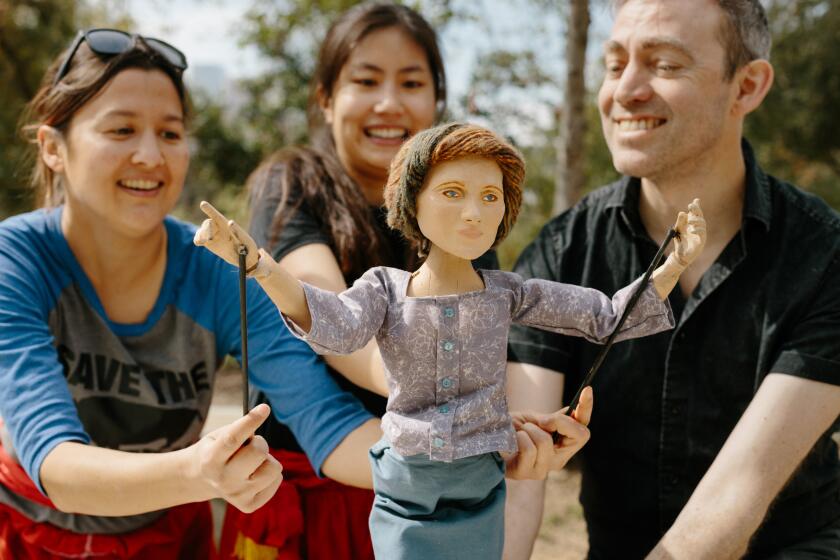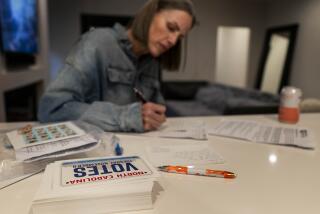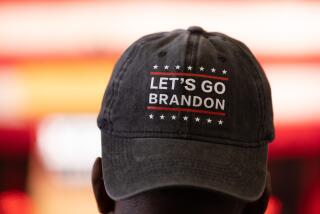
It’s hard to drive anywhere in the city right now without seeing an irreverent bumper sticker. Here’s how the trend went beyond ‘Coexist’ and into overdrive.
- Share via
- Los Angeles has reached peak bumper sticker: It’s now common to see cars displaying a rainbow of decals
- Today’s stickers often mimic classic formulations from bumper stickers past and declare loyalty to niche cultural ephemera.
- “You want to put a sticker on your car that’s so obscure that whoever finds it funny is destined to be your friend,” said bumper sticker aficionado Claire Evans.
Jeanne Vaccaro, a scholar and curator from Kansas, always wanted to become a bumper sticker person. For years, she collected stickers from artists, musicians and bookstores, but she kept them away from her vehicle, afraid that they’d damage the paint.
“It’s like a tattoo,” Vaccaro told me in Echo Park this past December. “Your mom tells you not to. It’ll, quote, ruin my car, unquote.”
But when she saw a scratch on her newly-purchased silver 2020 Subaru Impreza, she decided to cover the blemish with a sticker that said “All I want for my Bat Mitzvah is a Free Palestine,” the last two words large and bubbly, and filled with green and red to emphasize its political message.
It opened the floodgates. Now she has more than 25 stickers on the rear. There’s so many, they wrap around the sides, blasting colorful messages above the tires.

“Next came, ‘HONK IF YOU LOVE RELATIONAL AESTHETICS,’” said Vaccaro, who was dressed in a Betty Boop T-shirt and leopard print jeans the day we met. She gestured to a simple, black-and-white sticker in sans-serif font that reads “I’D RATHER BE CRYING TO ENYA.”
Hit the road in L.A., and you’re likely to spot a cheeky bumper sticker … or 17. Do you have a favorite? We want to hear from you!
The collection has since become quite varied. It includes a red-and-white bumper sticker that declares “I’d rather be withholding my labor,” which was designed by a poetry small press called Spiral Editions. (It’s technically a replacement; the first one was stolen from her car.) Her favorite is “Keep Honking! I’m thinking about the incomparable pool scene from Paul Verhoeven’s underappreciated 1995 erotic drama ‘Showgirls,’” a black sticker with white text that features lead actress Elizabeth Berkley’s lean profile.
“But I just have so many more that I can’t fit,” she said.
In August, Vaccaro took a sabbatical from the University of Kansas to curate the exhibition “Scientia Sexualis” at the Institute for Contemporary Art, Los Angeles. In the brief time she spent in the area’s Arts District, her vehicle became a local celebrity.
“I’ve had a lot of people send me photos from Instagram,” she said. “Friends of theirs saw my car, and people know that it’s me. I think that’s so special.”
Though some of her stickers are political, Vaccaro doesn’t believe her car ruffles any feathers.
They include tales of celebrity spottings, juicy overheards and workplace adventures unique to the City of Angels.
“I have not experienced any road rage or anger, and I’ve driven across the country many times,” Vaccaro said. Instead, she notices people through her rearview mirror, smiling. “It makes me happy that my car is bringing joy to the world.”
It’s hard to drive anywhere in L.A. right now without seeing an irreverent bumper sticker. In my own neighborhood of Echo Park, there’s “My other car is a Spirit Halloween,” which incorporates the brand’s grim reaper mascot; “Let me merge, my dad is dead” on a contradictory glittery, bubblegum pink background; and “KEEP HONKING! I’m Sitting In My Car Crying To The Cranberries 1993 Hit Single, ‘LINGER’” in a smattering of different-sized fonts.



Mara Herbkersman and Emily Bielagus, co-founders of the lesbian bar, The Ruby Fruit, sell branded bumper stickers that read: “keep honking. i’m listening to THE INDIGO GIRLS” for $5 each online. (Chiara Alexa / For The Times)
Cars have been emblazoned with advertisements and political messages ever since they came on the market, but the first adhesive bumper sticker can be traced back to 1946, when Forest P. Gill combined two wartime inventions, sticky paper and fluorescent paint. The first message Gill used for his discovery is lost to time, but his invention had sticking power. Political organizers were enthusiastic early adopters, and in 1952, Dwight D. Eisenhower’s presidential campaign became the first to embrace the art form. His supporters proclaimed “I LIKE IKE” on the back of their Cadillacs.
Bumper stickers quickly became a permanent fixture in popular culture. Over the last 80 years, Gill’s company would churn out millions of stickers for politicians and tourist traps. They often communicate personal ideology, ranging from a hippie’s transmission of peace and love to a veteran’s pride for his country. Or taste: In the 1970s, classical music die-hards in L.A. adorned their cars with the phrase “MAHLER GROOVES,” to show appreciation for the Austro-Bohemian Romantic composer and conductor Gustav Mahler. (Which the Los Angeles Philharmonic recreated this year to promote a Mahler-themed festival this winter.)
New businesses are reinvigorating the small desert city of 29 Palms, located just 20 minutes from Joshua Tree. Here are nine new shops worth checking out.
In 1991, a Supreme Court case, Cunningham vs. State, ruled that bumper stickers were protected under the 1st Amendment, which made cars one of the few places where people could widely, but semi-anonymously, make bold political statements.

In recent years, the creation of colorful, highly-specific bumper stickers have exploded, especially in the car culture capital of Los Angeles. At between $5 to $10 a pop, they’re an economical tool to communicate personal values. This new wave of stickers, however, is more concerned with cracking self-deprecating jokes or aligning with a niche fandom. There’s a bumper sticker for everybody. You can profess your love for John Cage, neon art or frogs. You can declare your other car is a poem, ask drivers not to stress out your dog or claim to be a silly goose.
“It used to be about expressing something universal,” says Claire Evans, an artist, writer and musician most known for being half of the synth-pop duo Yacht. “Now it seems to be a signal of one’s membership in a niche musical, artistic or internet subculture.”
Evans has been documenting bumper stickers in Los Angeles for years, and has built a reputation as a bumper sticker expert and connoisseur. In an attempt to innovate upon the artform, Evans even designed a suite of miniature stickers for phone cases.
Many of today’s amusing slogans play off classic formulas like “Keep honking, I’m [oblivious to the world because I’m listening to something obscure], or “Honk if you love [a quirky interest or interesting activity] or “I’d rather be [bleak statement confronting one’s mortality] or “My other ride is a [creative vehicle alternative].”
The familiar templates allow people to endlessly iterate upon the genre and invite a conversation on any topic. Creators start with a broad concept, then fine-tune every word within the sentence, dialing in the message until it’s personalized to their unique taste. Local businesses, like Silverlake lesbian bar The Ruby Fruit, have printed their own iterations to cater to their clientele. (Theirs, which sells for $5 online, reads: “keep honking, i’m listening to THE INDIGO GIRLS.”)


“You want to put a sticker on your car that’s so obscure that whoever finds it funny is destined to be your friend,” Evans said.
Perhaps no bumper sticker accomplishes what Evans describes better than, “Keep Honking! I’m Listening to Alice Coltrane’s 1971 Meteoric Sensation ‘Universal Consciousness.’” The yellow and black declaration designed by Echo Park-based artist Christopher DeLoach in 2020, arguably kicked off the current trend of esoteric car accessories.
DeLoach came up with the Coltrane sticker while working at Texino, a tech startup that sold luxury camper vans. The company asked him to make merchandise that would suit the vehicles, and he naturally gravitated towards bumper stickers. The design — simple Arial black text on a yellow background that changes size and position in different parts of the phrase — was inspired by a vintage pro-life bumper sticker a friend found from a small church in Mississippi.
In the last year, membership has spiked at the Los Angeles Guild of Puppetry. Inside the new generation of artists continuing its mission.
The feedback DeLoach received on the bumper sticker, as he puts it, was: “No one is going to understand this.” So DeLoach decided to sell it through his social media under the moniker “thatscoolthankyou.” It took off in 2021 and he estimates that he has since sold at least 3,000 of the Coltrane stickers, and has given away thousands more for free.


When I met DeLoach at his garage studio in Echo Park, he was sitting behind a retro Steelcase desk in a gray diamond-patterned blazer and black, collared shirt. In front of him were a stack of pre-addressed manila envelopes full of stickers that would soon be shipped off to people around the U.S. Also on the desk was a framed photo of a young DeLoach, who was born in Brooklyn, N.Y., posing with New York City’s former mayor, the infamous Rudy Giuliani. In front of the portrait, a nameplate read “Christopher DeLoach. Bumper Sticker Magnate.”
Despite the humorous tone of his creations, DeLoach has a surprisingly dark explanation for his bumper stickers’ success.
“The grave reality is that, in America, we exist in the most propagandized civilization of all time,” DeLoach said. “Everywhere you look, there’s branding and advertising. It has the secondary or tertiary effect of causing people to then want to act out and propagandize themselves.”
Since the success of the Coltrane sticker, DeLoach has come up with more than 120 designs. They appeal to every type of fandom, from followers of mega stars like Taylor Swift to devotees of the shoegaze pioneers Cocteau Twins. His second-most popular sticker is another one I spot regularly in bar bathrooms: a spoof of the famous interfaith “Coexist” bumper sticker of the mid-aughts. In DeLoach’s version, the religious symbols spell out “Cointelpro,” which refers to a covert operation led by the FBI to undermine radical political organizations.
There’s seemingly a sticker for everybody. But if you can’t find what you’re looking for, it’s easy to design your own. When Catalina Elias, an engineer living in Wrightwood, Calif., couldn’t find any stickers dedicated to flugelhorn player Chuck Mangione, she hopped onto Canva and made one that says, “Go ahead, keep honkin! I’m listening to Chuck Mangione’s 1977 hit ‘Feels So Good.’ ”

Though they’ve never met, Elias’s phrasing was inspired by DeLoach’s Coltrane sticker, which she had seen on Instagram.
Elias ordered 75 stickers, hoping she’d sell them, but never got around to it. Instead, she started giving them away for free. One day, she was hosting a yard sale and playing the song on repeat. It caught a neighbor’s attention.
“Some guy rode by with a really cool bike, and we gave him a bumper sticker, and now he’s one of our best friends,” she said.
The stickers also helped psychotherapist Jack Lam build camaraderie. Like Vaccaro, Lam put their “Honk if you’re a silly goose” sticker on their Toyota Prius to hide a scratch, but it’s also sentimental. A friend gave them the sticker because they knew they loved waterfowl.
Joining a club or society where you might meet like-minded people has a wide range of health benefits. We’ve rounded up some long-standing ones in L.A. to get you started.
For Christmas, Lam bought stickers as gifts for their group of friends, choosing phrases that best fit everyone’s unique personality.
“It’s whimsical and cute,” Lam said. “Now we all have a sticker, which is kind of beautiful.”
In a city that frequently isolates people into their car-shaped boxes, Evans believes that spying a relatable sticker can remind people of their shared humanity.

“Sometimes this hyper specific bumper sticker is a way of reaching across the highway and making a connection with another person.”
Do you have a favorite bumper sticker? Share it here.
More to Read
Sign up for The Wild
We’ll help you find the best places to hike, bike and run, as well as the perfect silent spots for meditation and yoga.
You may occasionally receive promotional content from the Los Angeles Times.















